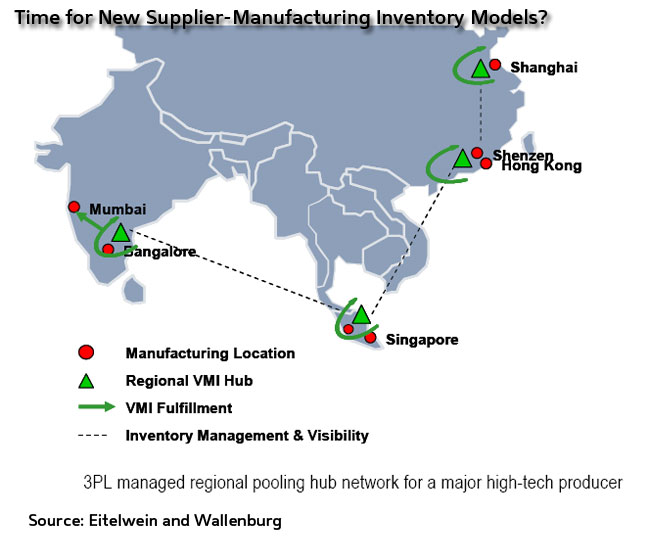So, some companies may be interested in evolving to a “buy-sell” logistics hub model.
According to Eitelwein and Wallenburg, the buy-sell logistics hub “would act as a virtual trading company between the raw materials and component suppliers on one side and the Contract Manufacturers on the other.”
In this model, the original manufacturer selects suppliers and negotiates prices. The CM can be invoiced either at this price, or a higher price that would reflect their price if they bought on the open market.
The management of the invoicing in this model could be performed by the 3PL or the brand company.
Of course, this model assumes that the brand owner can, in fact, source components for less than the CM – a proposition that may or may not be true. Some of the very large CMs may be able to source common components in greater volumes and at lower prices across many clients than the brand owners can themselves.
On the other hand, brand owners with more unique components needs or who use multiple CMs may have the greater price leverage with suppliers.
Eitelwein and Wallenburg also say that the limitations of many ERP implementations in dealing with “non-balance sheet” inventories and related Sarbanes-Oxley accounting rules may push a company towards greater 3PL involvement in the actual ownership of inventory and related accounting transactions.

Thinking Network Wide
Most logistics hubs today operate in a single threaded fashion – one hub supports a given factory or manufacturing campus.
Eitelwein and Wallenburg argue that taking a more total supply chain perspective could result in great overall efficiencies.
They cite, for example, one supplier of components to high-tech manufacturers that currently ships to some 35 logistics hubs for its brand customers. Each hub requires 2-4 weeks of inventory to be held – and many of the hubs are in close proximity to each other. The supplier suggests that if inventory were held at a more central location across brand owners, in a pooling type fashion for standard components, a substantial amount of inventory could be taken out of the system.
However, for a variety of reasons, such “inventory pooling” strategies have been difficult to make work in almost any industry sector.
New Models can Force 3PLs to Rethink their Operations
Currently, 3PLs are generally compensated based on their level of warehousing and transportation activities. While there are sometimes gainsharing agreements in place that at one level encourage 3PLs to find ways to reduce costs, the fact that more often 3PLs are compensated based on the volume of warehouse and distribution tasks provides a strong counter-incentive to maximizing those activities and revenues.
Eitelwein and Wallenburg say that new arrangements, such as greater use of gainsharing, may often make sense. They then suggest that even more “radical” solutions should be considered – such as the 3PL actually taking ownership of the inventory before it is shipped to production sites, thus taking the inventory risk off the brand owner. This would encourage a focus on total supply chain efficiency (warehousing, transportation, and inventory) and, as a result, might have substantial benefits to brand owners if also well tied to service level commitments.
However, Eitelwein and Wallenburg say that such an approach would require a “major change in mindset on the brand-owners’ side, away from arm’s length commodity relationships towards more strategic partnering” with 3PLs.
As 3PLs take on more risks, they would also need to be compensated for that – perhaps to a degree that doesn’t make sense for brand owners.
It is also not clear how many of even the leading 3PLs would be open or ready to such new types of relationships.
The research comes out of the “Kuehne-Center for Logistics Management,” sponsored by global 3PL giant Kuehne + Nagel; another 3PL giant, Schenker, supported this specific research by opening ups its operations to Eitelwein and Wallenburg, so the authors’ pro-3PL perspective has to be taken in that context.
Nonetheless, it is hard to think of new approaches to inventory management that don’t involve a different role for 3PLs – so manufacturers may want to start taking a look at new models that involve more than just logistics execution with 3PL partners.
Is it potentially smart – or even feasible – for 3PLs to take on greater supply chain responsibilities for manufacturers, especially with regard to inventory management and ownership? Are there other new models you are using or considering? Let us know your thoughts at the Feedback button below.
SCDigest is Twittering!
Follow us now at https://twitter.com/scdigest
|